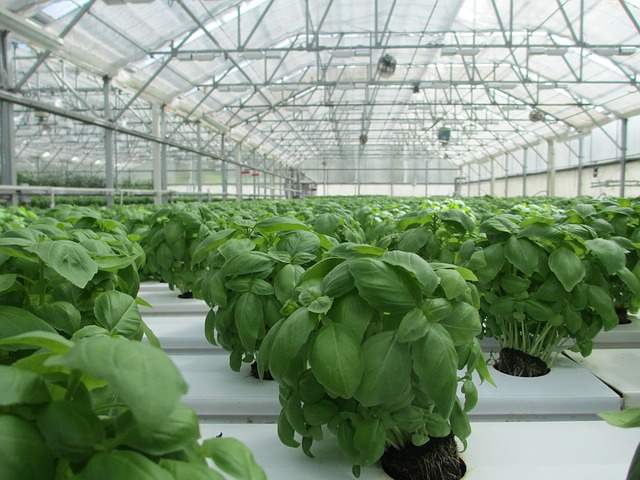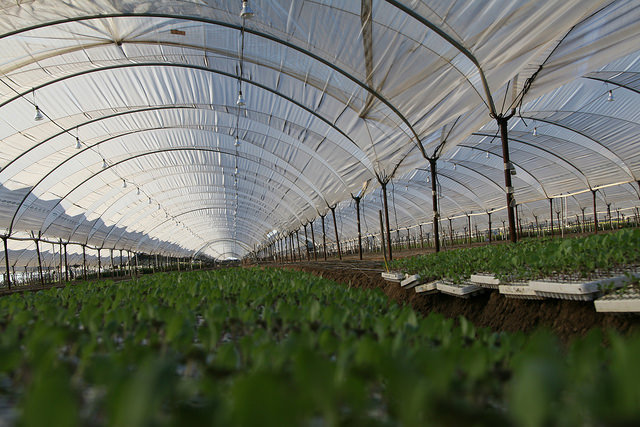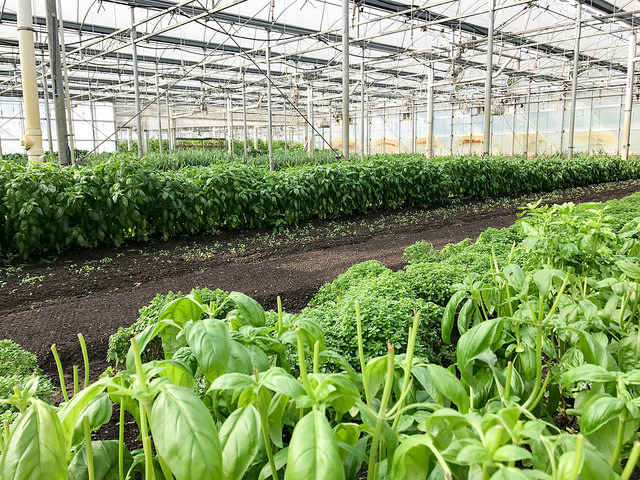
Polyhouse Farming Guide in India – The Pros and Cons
India has been an agriculturally dominated country since forever. The subtropical climatic conditions are most suitable for agriculture and have been for a long time. However, in the recent years the efficiency of produce or the turnout has been lower than the usual and huge losses have been faced.
To reduce losses and achieve a higher produce in the same amount or even lesser amount of investment greenhouse farming has been on the rise. The term greenhouse is basically coined for the gases that are responsible for global warming. They trap the heat and do not allow it to escape.
What is termed bad for the environment can be used for our benefits in a controlled surrounding. A greenhouse is a structure that is usually covered with glass, polyethylene or wood and the suitable conditions are maintained inside. The temperature inside is higher than that of the outside due to the presence of greenhouse gases.
A polyhouse is type of greenhouse which is covered around with polyethylene. This is the most commonly used type of greenhouse farming in India due to its cheap construction price. This is the most economical when compared to glass or wood, however, is the least durable. Here is a complete guide to polyhouse cultivation in India.
Contents
1. Selecting The Right Location
Initially, greenhouse farming was introduced with an aim to grow species in colder regions that require warmer climate. Later on, with advancements and research there were various other things one could grow at various places by adjusting the conditions appropriately. Some of the factors that need to be considered are as follows.
a) Pollution
The point of the greenhouse is to be efficient and provide the best suitable environment for the growth of crops hence it should be away from pollution. Away from pollution simply implies that there shouldn’t be any industrial plants and farming should be done a little outside city limits to also avoid vehicular carbon emissions.
b) Water Stagnation
The area where the greenhouse is built should not be in any case be a low-lying area which will pave way for water logging during monsoon and water release. This will destroy the crops. Extra care should be taken for areas that receive heavy rainfall.
c) Reachability
Though the polyhouse should be located at an area where it is away from pollution and the harmful gases emitted from industries and vehicles, it should be easily accessible and road connectivity should be good.
Considering these factors, a perfect location for the polyhouse can be selected and the construction can begin. The next step would be the possible conditions that can be created and the type of crops that would be most suitable.
2. Construction of Polyhouse

The difference in greenhouses is due to different cladding materials. Cladding is nothing but the covering of the structure or making a roof with different materials like fiberglass, polycarbonate, polyethylene and wood. However, polyhouse is concerned with cladding using polyethylene.
There are various components of greenhouse construction that include gable, gutters, bracings, arches, ridge and columns which provide structural stability and durability to the polyhouse. Apart from this, the three major types of polyhouses based on the construction type are as follows.
a) Low Tech and Cheap Polyhouse
These are the simplest type of polyhouses and require the least amount of money to be constructed. They are made of easily and locally available products like bamboos as supporting materials and the construction is done using these. They use a simple UV film for cladding and do not have high tech temperature adjusters.
However, low grade temperature and humidity controllers are present which serve the purpose. The light entering the polyhouse is controlled using shades on the transparent roof to modulate the intensity. They do not require much expertise and can be built in a very short span of time. They are mostly used as shelters for crops during heavy rains and snow.
b) Moderate Tech Polyhouse
These polyhouses are more durable than the above-mentioned ones since they are constructed using galvanised iron rods which are sturdier and offer more resilient to natural conditions. The structure is screwed and grounded firmly and offers better protection against high winds and harsh climate.
Thermostats are present in the polyhouse which precisely can manage temperatures. They are also fitted with exhausts which helps in controlling temperature and humidity. These are most suitable for areas that have a rather dry climate. They also require a lot of care and regular maintenance and repairs.
c) High Grade Polyhouse
This is referred for the more technologically advanced polyhouses that are equipped with latest technologies and have an automated system for everything. It overcomes the disadvantages of the latter two types with a technological solution.
3. Polyhouse Construction cost
Polyhouse construction cost depends on the type of polyhouse that is being adopted. The price undoubtedly increasing when moving towards high-tech from low-tech. The cheapest polyhouse construction can cost around Rs 500 per meter square without the addition of fans and pads. A medium tech polyhouse with pad and fan can cost up to Rs 1000 per meter square given there is no automation system employed.
The last is the costliest which is the high-tech polyhouse with all modern machineries and fully automated systems. They can cost up to Rs 4000 per square meter starting from Rs 2000 per square meter depending on the equipment.
The net profit that can be earned through polyhouse cultivation is estimated to be around 6-7 lakhs per acre per annum which is excludes the polyhouse farming cost. It is a pretty good source of income as well and at the same time is good for the environment and to maintain the quality of the crops.
4. Suitable Crops for Polyhouse Cultivation
The crops grown in a polyhouse aren’t the conventional paddy and Rabi crops that can be grown on a field. The crops grown in a polyhouse are usually the unconventional types which do not need further much further processing and can be sold directly in the market.
This comprises of fruits, vegetables and flowers to sum up into three categories. The fruits usually are papaya, strawberry and mangoes which can be grown all year round by maintaining the conditions.
Various vegetables like bitter gourd, cabbage, capsicum onions, tomatoes, okra and chili, coriander and roots like radish and carrot. Most flowers are grown in horticulture style in a house gerbera, gladiolus, marigold, orchid and rose. Cucumber, bell pepper and some exotic plants that do not grow in the Indian climate can also be grown.
5. Types of Polyhouse

Though polyhouses are classified into categories based on different aspects, this one is based on environmental control systems and is hence a major deciding factor for those who are planning on building a polyhouse and initiating polyhouse cultivation.
a) Naturally Ventilated Polyhouse
These polyhouses do not pay much attention to an environmental control system and adequate ventilation is provided in the polyhouse. Adequate ventilation and a fogger system makes sure that the crops are protected from other pests and diseases. This type of polyhouse is built when the main aim is to prevent the crops from adverse weather and harsh climatic conditions.
b) Artificially Environment Controlled Polyhouse
This polyhouse believes in artificial methods of environment control and is used to extend the growth period of the crops. They use environmental control systems to control the temperature of the room, controlling light intensity in the room and also to control the carbon dioxide levels and humidity. This is basically misguiding the plant mechanism to believe into the suitability of the environment and achieve growth of the seasonal plants even during their off season.
6. Advantages of Polyhouse Cultivation
There are various advantages of polyhouse cultivation over regular farming. That is why we are seeing an uprise in polyhouse cultivation. There are over almost a million different polyhouse plants in India and there are more to come in the coming years to meet the market demand. The temperature of the environment can be controlled according to the needs and the yield obtained could be better.
High humidity can also be adjusted accordingly. In an open field, the crops are more to prone to attacks by pests and insects which makes the farmers spray insecticides and pesticides that are harmful for us. Polyhouse cultivation reduces or rather removes the need of any pesticides and chemicals thus keeping the crops healthier for consumption and not reducing its nutritional values. In an open field, invasion by animals and birds also result in almost one third of the crop being lost and this can definitely be avoided in a polyhouse.
The agricultural land in India has been reducing and polyhouse farming is the best way to overcome the situation. This is why there are various polyhouse farming training camps conducted in various parts of the country in various institutes that will promote the growth of polyhouse cultivation. We can get more produce and more crops by farming in a controlled manner and the profits and the quality of the produce is always higher in this case.
7. Disadvantages of Polyhouse Cultivation
Every good thing has its cons too. However, when compared with the pros, the cons should seem manageable and the project should look viable. The cons can be overcome to have better results. The cost of polyhouse construction can sometimes go high due to high demand in the market.
To save money the construction is often compromised with low quality raw materials and may take a hit of stability during harsh weathers. Farmers aren’t aware of it yet and that is one thing that needs to be spread as fast as possible. Increasing temperatures during summer can sometimes damage the cladding of the polyhouse. After spraying the fertilizers, no one should enter the polyhouse for a few hours due to decrease in the level of oxygen and fresh air.
This can sometimes be dangerous for people and can cause breathing issues. Irrigation can sometimes be challenging as just one type of irrigation in the polyhouse may not be suitable for crop types and hence needs to managed efficiently. The maintenance cost of the polyhouse is rather high if mishandled and proper care is not taken.
This was a complete guide for someone who is out there looking for a future in polyhouse cultivation. It is not only good for business but is also very good for the environment and you can do your bit for our planet earth. You can also hire good employees and staff who are trained in polyhouse farming and can move in with the work in a professional swing.


